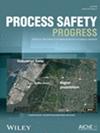在老化海上设施中实施定量风险和成本效益分析
IF 1
4区 工程技术
Q4 ENGINEERING, CHEMICAL
引用次数: 0
摘要
安装立管关闭阀(sdv)是为了通过海底管道隔离碳氢化合物,或者保护平台和人员免受意外碳氢化合物泄漏的影响。不幸的是,通过SDV泄漏的气体体积有时会超出预定的标准。因此,需要通过成本效益分析(CBA)进行定量的风险评估。这是本研究的方法论。首先,我们执行频率分析,使用释放频率的估计、事件树分析和结果建模的升级,从可隔离的部分计算释放频率。其次,我们研究了建模的后果。第三,我们进行风险分析和评估。第四,我们做CBA计算。第五,我们考虑其他方面。研究结果可以预测海上设施老化期立管SDV泄漏的可能性,在保证安全的同时优化运营和投资成本,降低火灾爆炸的可能性。由于涉及多个潜在贡献者和多种安全措施的操作系统的复杂性,它提出了一个挑战。研究结果表明,在最坏情况下,有加工设施的SDV火灾预测概率从8.10 × 10−09增加到7.93 × 10−05。实例分析表明,CBA模型可用于安全投资的优化配置。本文章由计算机程序翻译,如有差异,请以英文原文为准。
Implementation of quantitative risk and cost–benefit analysis in an aging offshore facility
Riser shutdown valves (SDVs) are installed to isolate hydrocarbon through a subsea pipeline or to protect platforms and personnel from an unintended release of hydrocarbons. Unfortunately, the volume of gas leaking through the SDV is sometimes beyond the predetermined criteria. Therefore, a quantitative risk assessment is needed by conducting cost–benefit analysis (CBA). This is the methodology of this study. First, we carry out a frequency analysis to calculate the frequency of release from an isolatable section using an estimate of the release frequency, event tree analysis, and escalation from consequence modeling. Second, we study the consequences of modeling. Third, we carry out risk analysis and evaluation. Fourth, we do CBA calculation. Fifth, we consider the other perspectives. The results of this study can predict the possibility of riser SDV leakage in offshore facilities during the aging period and optimize operating and investment costs while maintaining safety to reduce the possibility of fire explosions. It poses a challenge because of the complexity of operational systems involving multiple potential contributors and multiple safety measures. The study results show that the probability of fire prediction at SDV with processing facilities increases from 8.10 × 10−09 to 7.93 × 10−05 for the worst case scenario. Case studies show that application of the CBA model can be used to optimize the allocation of safety investments.
求助全文
通过发布文献求助,成功后即可免费获取论文全文。
去求助
来源期刊

Process Safety Progress
工程技术-工程:化工
CiteScore
2.20
自引率
10.00%
发文量
99
审稿时长
6-12 weeks
期刊介绍:
Process Safety Progress covers process safety for engineering professionals. It addresses such topics as incident investigations/case histories, hazardous chemicals management, hazardous leaks prevention, risk assessment, process hazards evaluation, industrial hygiene, fire and explosion analysis, preventive maintenance, vapor cloud dispersion, and regulatory compliance, training, education, and other areas in process safety and loss prevention, including emerging concerns like plant and/or process security. Papers from the annual Loss Prevention Symposium and other AIChE safety conferences are automatically considered for publication, but unsolicited papers, particularly those addressing process safety issues in emerging technologies and industries are encouraged and evaluated equally.
 求助内容:
求助内容: 应助结果提醒方式:
应助结果提醒方式:


